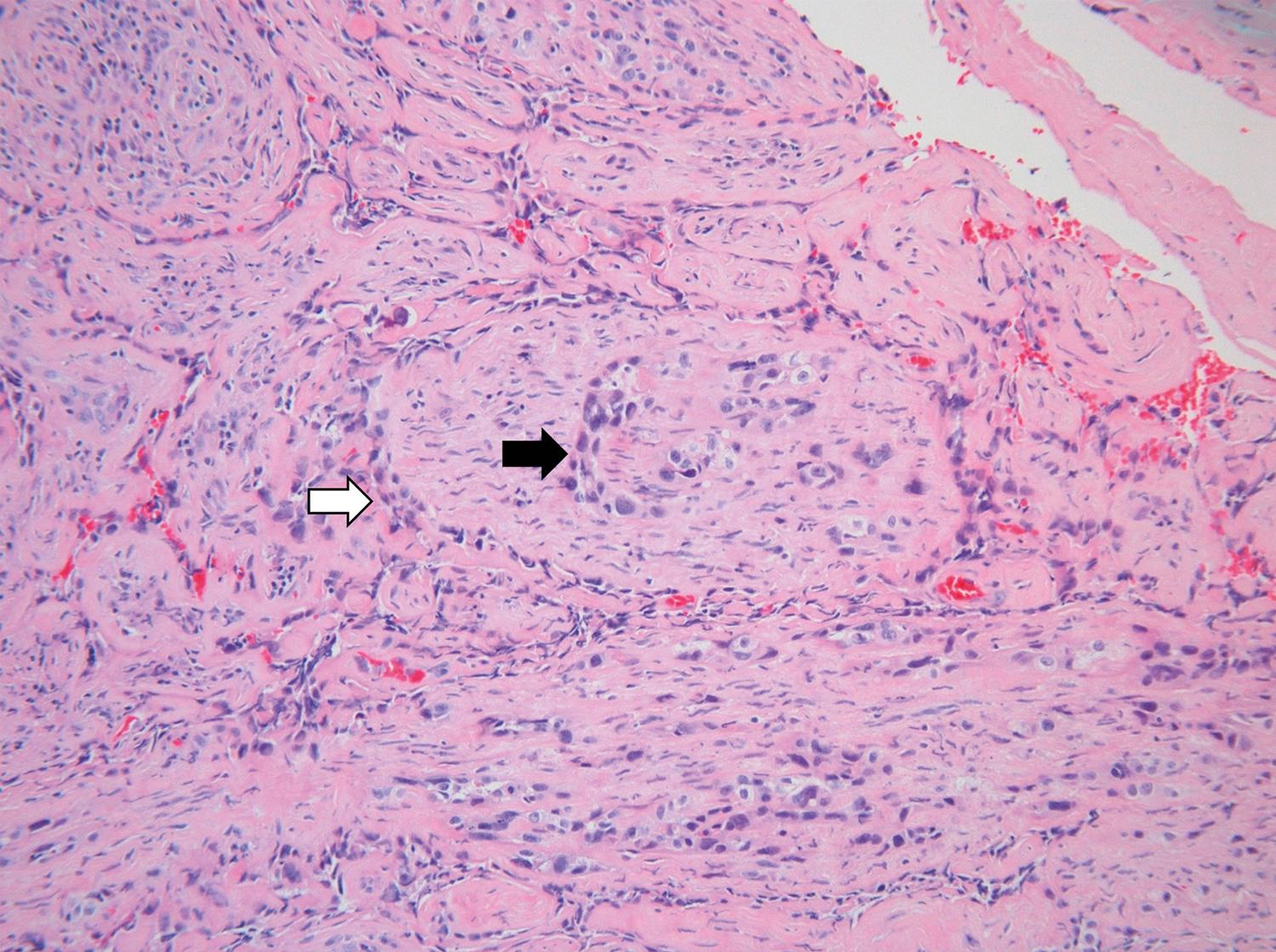Physical Address
304 North Cardinal St.
Dorchester Center, MA 02124
Perineural invasion (PNI) refers to a rare type of contiguous spread of neoplastic cells from their primary site along the potential space between or beneath the layers of perineurium. This entity is best described in cancers of the head and neck but is also well described in other solid tumors. Exact pathogenesis remains unclear, but proximity of the primary tumor to major nerves and plexus and the tumor cell’s ability to infiltrate and proliferate within the perineural space, as well as directed molecular interactions between the tumor and its microenvironment, are thought to play an important role. The clinical presentation varies depending on the nerves involved. Developing a broad differential to include direct compression of nerves by tumors, delayed effects of prior radiation therapy, infections, and paraneoplastic syndromes as well as work-up for other common causes of neuropathies is encouraged. Contrast-enhanced magnetic resonance imaging is the imaging modality of choice, but a biopsy is frequently required for confirmation of diagnosis. Accurate detection may help predict prognosis and guide therapy. We recommend a multidisciplinary approach in selecting the curative and palliative treatment options.
PNI refers to a rare type of contiguous spread of neoplastic cells from their primary site along the potential space between or beneath the layers of perineurium ( Fig. 21.1 ). It is defined as “tumor in close proximity to nerve and involving at least 33% of its circumference or tumor cells within any of the three layers of the nerve sheath (epineurium, perineurium and endoneurium).” It was first described in 1952 by Dr. Frederick Mohs and Dr. Theodore Lathrop as “silent” extensions along the nerve sheath. Even though this phenomenon is frequently discussed in patients with primary head and neck malignancies, it is well defined in malignancies of the pancreas, prostate, and colorectum. Perineural invasion can be broadly divided into two main categories based on the patient’s clinical presentation:
Microscopic perineural invasion (MPNI) is the asymptomatic type (60–70%) where diagnosis is made on surveillance imaging, biopsy, or autopsy.
Clinical perineural invasion (CPNI) is the symptomatic type (30–40%). ,

Another approach to their classification is to differentiate between the type and caliber of nerve that is involved:
Perineural invasion ( PNI) is used to describe involvement of small, unnamed nerves around a tumor.
Perineural spread (PNS) is the term used when there is evidence of invasion and spread along a larger, named nerve or cranial nerves.
Although both can result in symptoms, PNS is generally considered to be more aggressive and frequently presents with neuropathy of the affected nerve. ,
The exact pathogenesis remains unclear, but the proximity of the primary tumor to major nerves and plexus and the tumor cell’s ability to infiltrate and proliferate within the perineural space, as well as directed molecular interactions between the tumor and its microenvironment, are thought to play an important role. Additionally, tumor-associated macrophages, Schwann cells, and other cells in the tumor microenvironment such as fibroblasts and extracellular matrix adhesion proteins may play an important role in perineural invasion and spread. A review of the literature suggests that cells capable of producing neurotropins, including nerve growth factor, brain-derived neurotropic factor, and glial cell line–derived neurotrophic factor, are linked to PNI in multiple type of cancers. Similarly, several studies have suggested that prostate tumor cells located adjacent to nerves have increased proliferation rates compared to those located further away, suggesting a dynamic interaction. , Evidence of PNI predisposes locoregional recurrence even after complete resection. The presence of PNI is independently associated with decreased survival. Due to its prognostic and predictive implications, the College of American Pathologists recommends including perineural space invasion in histopathologic reports for all cutaneous and head and neck malignancies. It is estimated that around 2–6% of patients with malignant head and neck tumors have evidence of PNS, whereas other tumors, such as prostate cancer, may demonstrate up to 75% PNI without significant PNS. , ,
In head and neck cancers, PNS frequently affects cranial nerves V (CN V) and VII (CN VII). , , Patients with high-grade or poorly differentiated tumors, tumors involving the mid-face, male gender, and large primary tumors are at a higher risk of developing PNI. , Presenting symptoms are subtle, variable, and usually progress over the years. If the CN V is affected, symptoms include numbness (72%), pain (46%), or paresthesia. Patients may describe this sensation as ants crawling underneath the skin (formication) (10%). Similarly, patients may present with lower motor neuron type facial palsy if the CN VII is affected (33%). , , The pattern of nerve involvement is closely related to the primary location of the tumor. For example, tumors of the supraorbital region tend to invade CN V1 (ophthalmic nerve), whereas tumors of the medial cheek invade CN V2 (47%) (maxillary nerve). Similarly, tumors of the temporal region invade CN V2 and CN V3 (mandibular nerve), whereas tumors of the peri-auricular region invade CN VII (26%). , The subtleness of the symptoms and slow progression over months to years may cause an incorrect diagnosis, such as Bell’s palsy or trigeminal neuralgia. A high index of suspicion and good history will help broaden the differential diagnosis and aid in early detection.
Become a Clinical Tree membership for Full access and enjoy Unlimited articles
If you are a member. Log in here